The Best Spring Pea & Asparagus Risotto Recipe For Fresh Flavor
Crafting a delightful spring pea and asparagus risotto promises a culinary adventure that celebrates seasonal freshness.
Vibrant green vegetables dance through creamy arborio rice, creating a symphony of textures and flavors.
Italian cooking traditions shine in this elegant dish that feels both sophisticated and comforting.
We blend tender asparagus spears with sweet peas, letting each ingredient tell its own story.
Slowly stirred with patience, the risotto develops a luxurious consistency that melts beautifully on your palate.
Parmesan cheese adds a subtle nutty depth that complements the vegetables’ natural sweetness.
Fragrant herbs provide a final whisper of brightness that makes this recipe truly memorable.
Take a deep breath and savor the promise of spring in every delectable spoonful.
Why Spring Pea & Asparagus Risotto Shines
Ingredients for Spring Pea & Asparagus Risotto
Main Ingredients:Aromatics:Finishing Ingredients:How to Prepare Spring Pea & Asparagus Risotto
Step 1: Warm Up The Liquid
Pour vegetable broth into a saucepan and heat over medium temperature until it reaches a gentle simmer. Keep the broth warm and ready throughout the cooking process.
Step 2: Create Aromatic Base
Heat olive oil in a large skillet and sauté finely chopped onions and minced garlic until they become soft and translucent, releasing their delightful fragrance.
Step 3: Toast The Rice
Add Arborio rice to the skillet and stir continuously for about 2 minutes, allowing the grains to become slightly toasted and develop a nutty aroma.
Step 4: Slowly Incorporate Broth
Begin adding warm broth to the rice one ladleful at a time, stirring consistently. Each addition of broth should be fully absorbed before adding the next portion.
Continue this process for approximately 18-20 minutes until the rice becomes creamy and tender.
Step 5: Add Spring Vegetables
Gently fold in fresh ingredients:Cook for an additional 5 minutes until vegetables are bright and tender.
Step 6: Finish And Serve
Remove skillet from heat and stir in freshly grated Parmesan cheese. Season with salt and black pepper to taste.
Transfer to serving dishes immediately while the risotto is warm and creamy.
Helpful Tips for Pea & Asparagus Risotto
Variations for Spring Pea & Asparagus Risotto
Pairing Ideas for Spring Pea & Asparagus Risotto
Crisp sauvignon blanc perfectly complements the bright, verdant flavors of the risotto, cutting through its creamy richness with zesty citrus notes.
Grilled lemon-herb chicken provides a light, lean protein that enhances the risotto’s delicate vegetable essence without overwhelming its subtle spring vegetable profile.
Toasted pine nuts sprinkled on top add a delightful crunch and nutty depth, creating a textural counterpoint to the smooth, creamy risotto while amplifying its earthy undertones.
Simple arugula salad with shaved Parmesan and light lemon vinaigrette rounds out the meal, offering a peppery freshness that echoes the risotto’s green vegetable character.
Storage Tips for Pea & Asparagus Risotto
FAQs
Arborio rice is a short-grain Italian rice with high starch content that creates a creamy texture when cooked slowly, making it perfect for traditional risotto dishes.
Yes, frozen vegetables work well. Just thaw and drain them before adding to the risotto to prevent excess moisture.
The risotto is done when the rice is tender but still has a slight bite (al dente) and has a creamy, flowing consistency that spreads slightly on the plate.
Frequent stirring is crucial to release the rice’s starches and create a creamy texture, but you don’t need to stir every single second – just regularly and consistently.
Print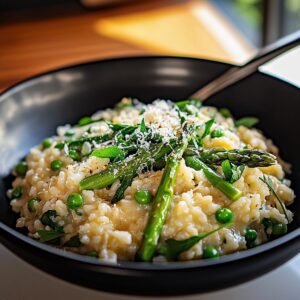
Spring Pea & Asparagus Risotto Recipe
- Total Time: 35 minutes
- Yield: 4 1x
Description
Creamy spring pea & asparagus risotto brings Italian comfort to your table with fresh seasonal vegetables. Herbaceous and light, this dish delivers pure springtime elegance you’ll savor with each delightful spoonful.
Ingredients
Main Ingredients:
- 1 cup arborio rice
- 2 cups fresh green peas
- 1 cup asparagus, chopped
Vegetables and Aromatics:
- 1 onion, finely chopped
- 2 cloves garlic, minced
Liquids and Seasonings:
- 4 cups (960 milliliters) low-sodium vegetable broth
- 1/2 cup (120 milliliters) grated Parmesan cheese
- Olive oil (2 tablespoons, 30 milliliters)
Instructions
- Prepare a pot of vegetable broth, heating it to a gentle simmer over medium heat and maintaining its warmth throughout the cooking process.
- In a spacious skillet, transform chopped onions and minced garlic into a translucent, fragrant base by sautéing them in olive oil until softened.
- Introduce Arborio rice to the skillet, allowing it to toast and develop a nutty aroma for approximately 2 minutes, stirring constantly to prevent burning.
- Incrementally ladle the warm broth into the rice, stirring methodically to encourage gradual absorption and create a creamy consistency. This process will take around 18-20 minutes.
- When rice is nearly tender, gently incorporate fresh peas and tender asparagus pieces, letting them cook and integrate with the risotto for an additional 5 minutes.
- Finish the dish by folding in freshly grated Parmesan cheese, then season with salt and freshly ground black pepper to enhance the flavors.
- Transfer the risotto to warm serving plates immediately, ensuring the creamy texture is preserved and enjoyed at its peak temperature.
Notes
- Achieve creamy risotto by stirring consistently, allowing rice to release natural starches while preventing sticking.
- Swap Arborio rice with other short-grain varieties like Carnaroli or Vialone Nano for similar texture and absorption qualities.
- Keep vegetable broth warm throughout cooking to maintain consistent temperature and prevent rice from cooling down during liquid additions.
- For a lighter version, reduce Parmesan cheese quantity or use nutritional yeast as a dairy-free alternative that provides similar umami flavor profile.
- Prep Time: 10 minutes
- Cook Time: 25 minutes
- Category: Lunch, Dinner
- Method: Sautéing
- Cuisine: Italian
Nutrition
- Serving Size: 4
- Calories: 280 kcal
- Sugar: 3 g
- Sodium: 150 mg
- Fat: 7 g
- Saturated Fat: 2 g
- Unsaturated Fat: 5 g
- Trans Fat: 0 g
- Carbohydrates: 45 g
- Fiber: 5 g
- Protein: 10 g
- Cholesterol: 7 mg

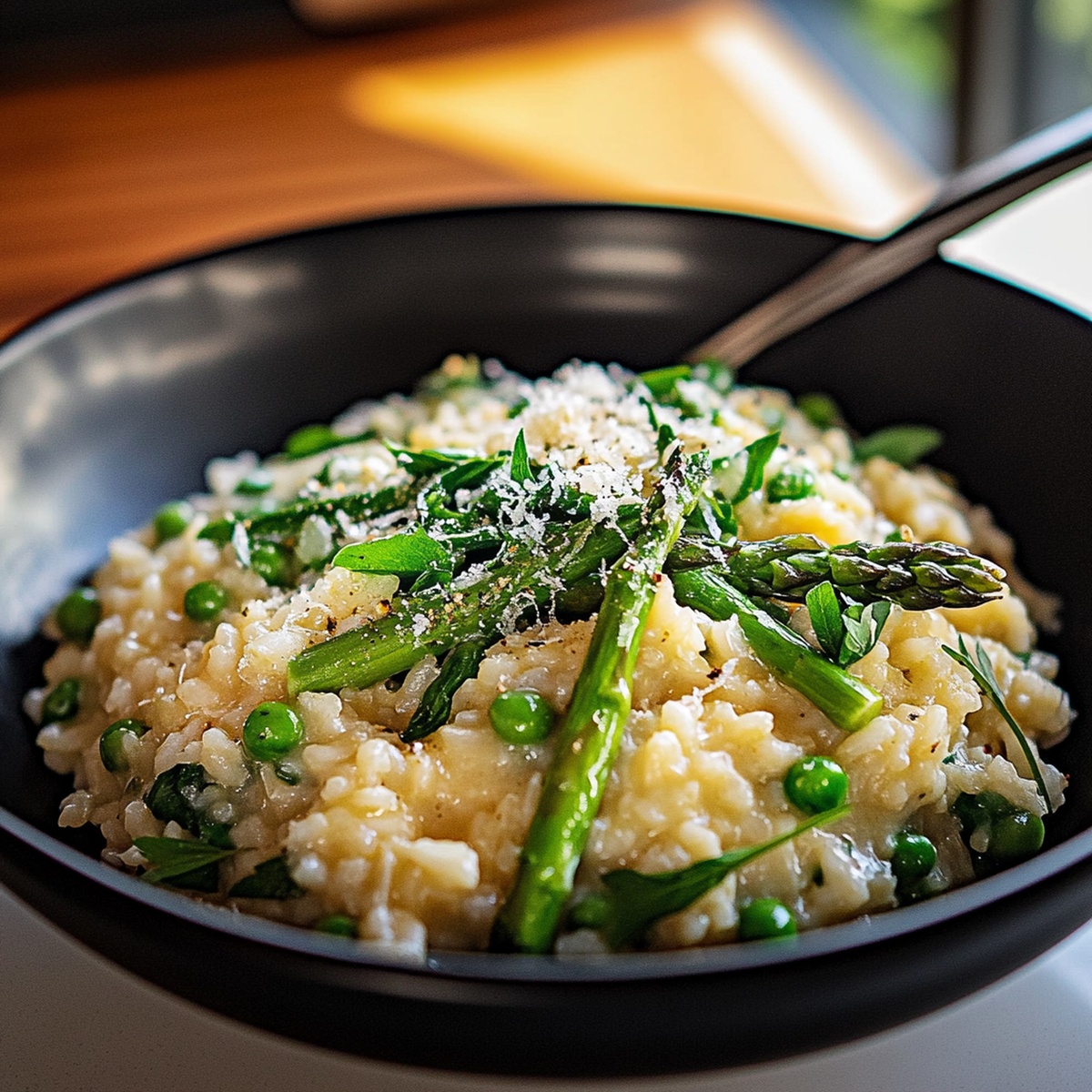
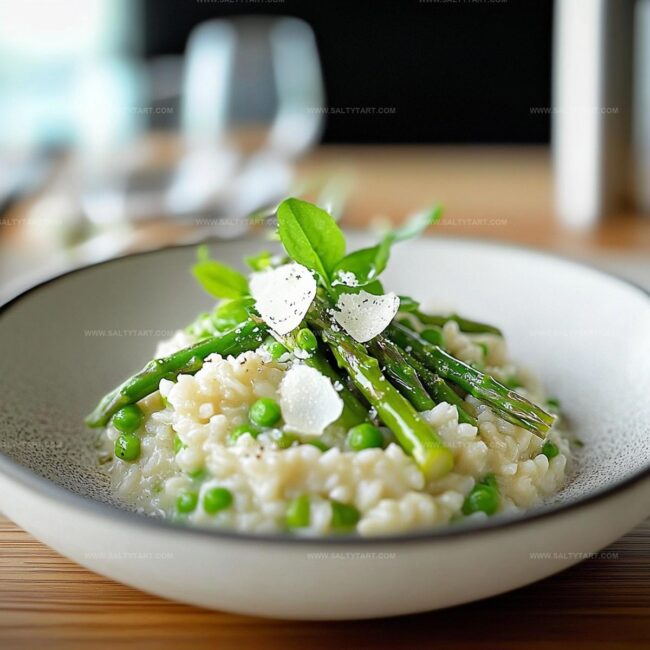
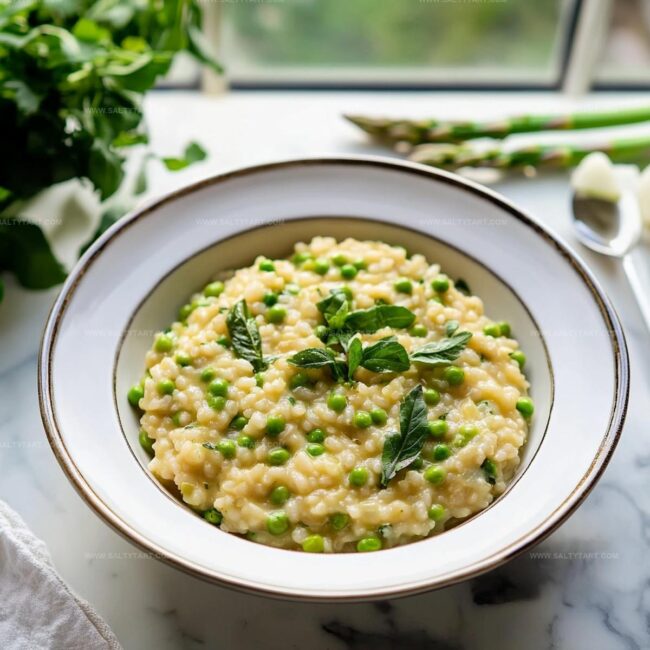
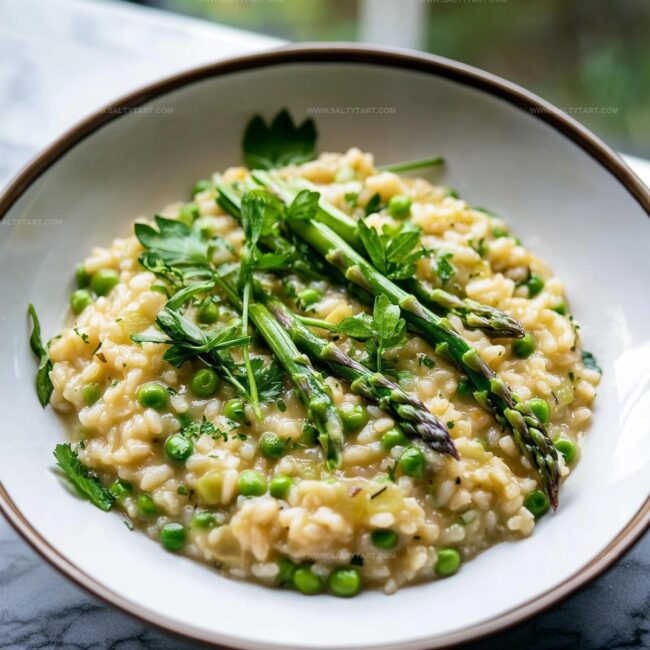
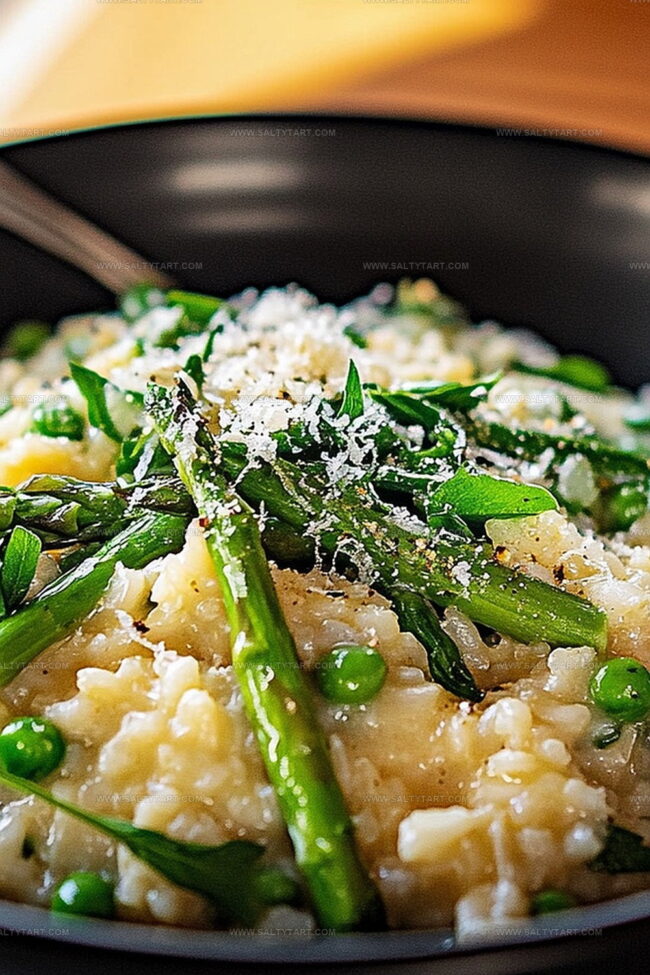

Mike Reynolds
Founder & Recipe Developer
Expertise
Farm-to-table cuisine, Seasonal recipe development, Sustainable cooking techniques, Food photography
Education
Asheville-Buncombe Technical Community College (A-B Tech)
Associate Degree in Culinary Arts
Mike studied culinary arts with a strong focus on farm-to-table principles and sustainable cooking. His training emphasized the importance of fresh, local ingredients and environmentally responsible practices in the kitchen.
Mike’s food journey began deep in the Blue Ridge Mountains, where weekends at farmers’ markets and home-cooked meals sparked a lifelong obsession with simple, seasonal eating.
After earning his Associate Degree in Culinary Arts from Asheville-Buncombe Technical Community College, he set out to bring farm-to-table cooking into everyday kitchens, without the fuss.
Mike’s philosophy is all about keeping it fresh, unfussy, and full of heart. When he’s not crafting new single-serving recipes, he’s hiking mountain trails, chatting with local farmers, or experimenting with wild ingredients in his backyard kitchen.